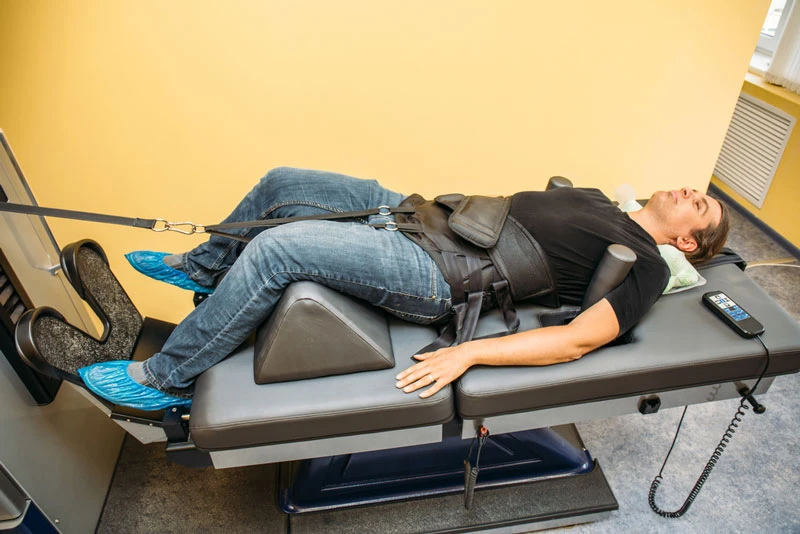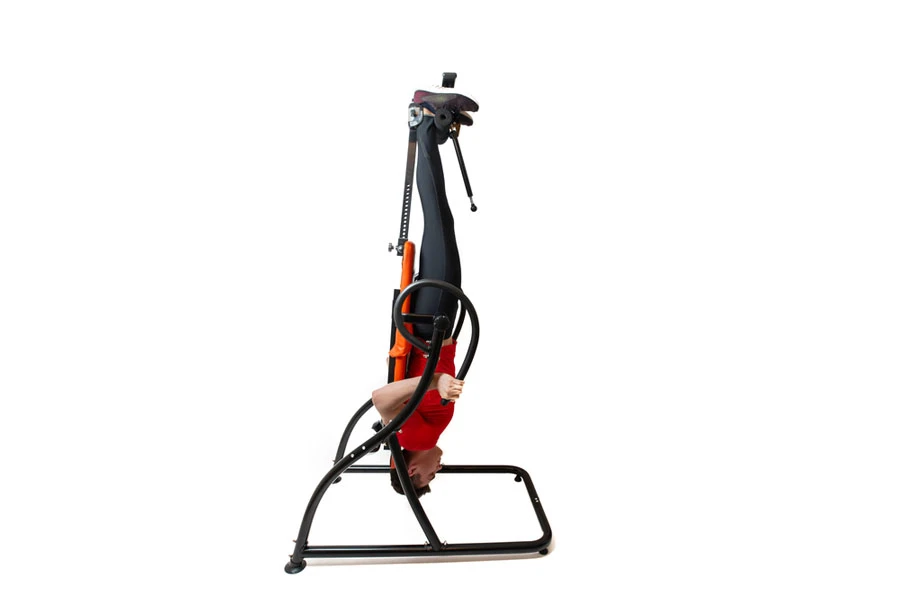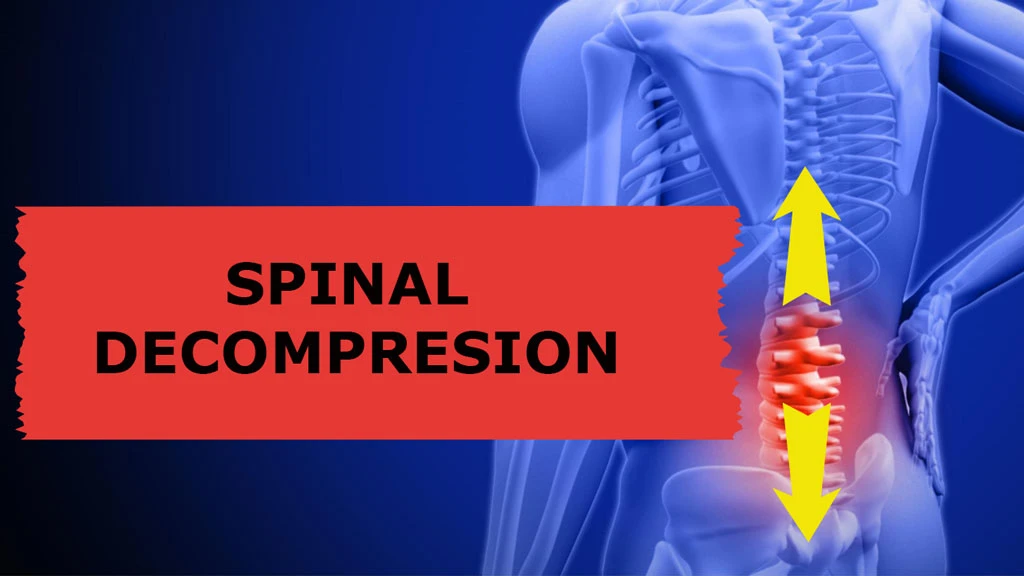Spinal decompression therapy has been researched and proposed as a suitable method for alleviating back/sciatica pain but what does it entail and how does it work.
Spinal decompression therapy has been shown in studies to significantly decrease pain in those suffering from lower back pain from conditions such as herniated discs or disc degeneration.
Contents
- What conditions would warrant the use of spinal decompression?
- How does spinal decompression work?
- What types of spinal decompression are available?
- Spinal decompression methods Pro’s and Con’s
- So what is the best type of spinal decompression?
- So what is ELDOA then?
- How do these spinal decompression stretches help?
- Long term benefits of spinal decompression stretches
- Can I try some of these decompression stretches at home?
- How soon can I see an improvement by using spinal decompression stretches?
What conditions would warrant the use of spinal decompression?
The main injuries that are treated via spinal decompression are those in which there is increased pressure on your spine leading to pain.
The four main conditions that have been shown to have great results with spinal decompression are;
– Sciatica
– Bulging discs/disc herniations
– Degenerative Disc Disease
How does spinal decompression work?
Spinal decompression reduces the pressure on the discs by increasing the space between your vertebrae or between your vertebrae and nerves.

This relief of stress simultaneously promotes regeneration of diseased and compressed discs and increases lumbar disc height, with the latter reducing load on the facet joints.
What types of spinal decompression are available?
Surgical intervention
Mechanical such as the DRX-9000
At home decompression (inversion) table – X3 Inversion
ELDOA – at home stretches
Spinal decompression methods Pro’s and Con’s
Surgery – with any surgery come risks and decompression surgery is no different. Whenever you go under the knife you run the risk of complications.

Surgery is not a guaranteed fix and back surgery has a relatively high failure rate with many people having to go back for repeated surgeries which actually increase the chance of a further failure.
I would always exhaust every conservative lower back pain management resource before considering lower back surgery.
Mechanical spinal decompression – Much of the research has focused on mechanical decompression by a form of traction on the spinal discs.

It has shown to be beneficial for many people suffering from disc herniation’s, sciatica and disc degeneration.
One of the biggest problems with this type of treatment is cost.
From a basic internet search, the average cost is $3000-$4000 for a 6 week course inclusive of around 20 sessions.
At home decompression (inversion) tables – these are a cheaper option than going to a specialized clinic and can range from a few hundred dollars up to thousands.
You can simply set it up in the comfort of your own home and use it as and when you need it.

The problem with these is there is no real targeted decompression happening with these devices.
You strap yourself in and essentially hang upside down and allow gravity to decompress the spine.
As a result, the benefits are usually short lived and you do not get the true benefits associated with targeted spinal decompression.
ELDOA – this is a form of targeted decompression stretching which needs no equipment and can be done at work, at home, in the gym, in fact anywhere with a little bit of floor space.
It was developed by Dr Guy Voyer more than 30 years ago and has been used successfully used by him and his practitioners to bring relief to patients all over the world.
You do not need a partner or have to spend thousands of dollars to get the benefits of these stretches and they can be found on youtube if you search.
It is advisable though that if you want to get the most out of them to have someone trained in the methodology take you through them.
This will allow you to understand the movement correctly and get the most benefit out of them.
So what is the best type of spinal decompression?
Okay disclaimer time, I am in unanimous favor of ELDOA over any of the above!
Why you might ask?
Well, I was lucky enough to enrol on the ELDOA course with Guy Voyer right after I was diagnosed with my disc herniations.
Along with the other modalities I was implementing I believe this to be the number one thing that brought me back from getting surgery and leading a normal life again.
That is why these types of stretches are at the core of my lower back/sciatica pain rehabilitation course.
So what is ELDOA then?
It stands for Elongation Longitudinaux Avec Decoaption Osteo-Articulaire (ELDOA), yes Guy Voyer is French.
Or in English Longitudinal Osteo-Articular De-coaptation Stretching (LOADS).
It can be described as a fascial stretch that localizes tension at the level of a specific spinal segment and creates decompression.
How do these spinal decompression stretches help?
As these stretches are targeted they have many benefits for many ailments and can help with:
– Disc rehydration
– Improvement of herniated/bulging discs
– Reduce nerve pain such as sciatica
– Reduced pain from degenerative disc disease
– Improves postural discrepancies such as scoliosis
– Reduce pain from the likes of spinal arthritis
– Improvement spinal stenosis
The benefits are not only short term but with consistent practice, they lead to long term benefits and outcomes
Long term benefits of spinal decompression stretches
These ELDOA stretches require a certain amount of tension to be created, this tension is created by the individual assuming certain positions and holding these for an allotted time.
This leads to a greater kinesthetic sense of where the body is in space leading to improved spinal alignment.

It also improves the strength and endurance of the muscles that lie closest to the spine which help with spine stability and this, in turn, can lead to a decrease in pain.
This is something that is not available to any of the other decompression techniques and is in my opinion why I believe it to be the best modality.
Can I try some of these decompression stretches at home?
Yes you can!
Below I have a couple of videos where I go over two very important spinal decompression stretches for the lumbar spine.
L5 S1 spinal decompression stretch
And here I go over a spinal decompression stretch for L4 L5
How soon can I see an improvement by using spinal decompression stretches?
Like any modality consistency is key and you need to be prepared to put in some time and effort to see results.
Most people start to see a reduction in pain after 2 to 3 days of doing these stretches and I have had a few people become completely pain free within 2 weeks.
I have even had a client whose disc herniation actually reabsorbed, as was discovered on a subsequent MRI.
Now were these results down to just the stretches or a combination of the modalities I prescribed?
Well, it is hard to say which one contributed the most but there is a reason I have included these as a major part of my lower back/sciatica pain recovery course.
Please give them a try and feel free to leave a comment here or on youtube.
If you want to keep up to date with further information about how to reduce your back/sciatica pain then sign up for my weekly email list here.
If the information contained within this article has been useful please share it with others you feel may need help with their lower back disorders.
Spread the love people!

